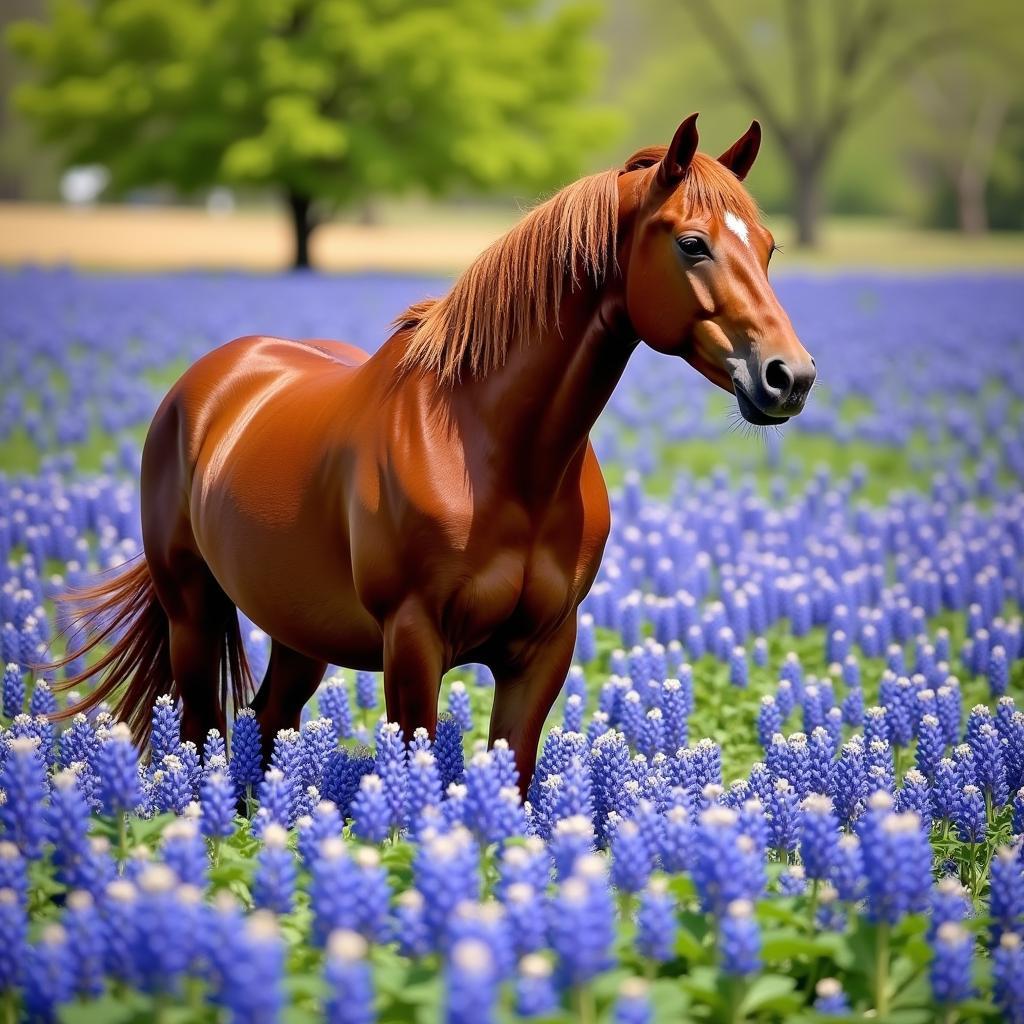The Bluebonnet Horse is a captivating image that embodies the spirit of Texas springtime. The sight of these majestic animals amidst a sea of vibrant bluebonnets is a photographer’s dream and a testament to the beauty of the natural world. But beyond the stunning visuals, the bluebonnet horse holds a unique place in Texan lore and tradition.
Unveiling the Myth: Are Bluebonnet Horses Real?
The term “bluebonnet horse” itself might conjure images of a rare, blue-hued breed. However, there’s no such thing as a horse with blue bonnets as a natural coat color. The magic of the “bluebonnet horse” lies in the perfect harmony of timing and scenery. It’s the breathtaking combination of any horse breed, from elegant Thoroughbreds to sturdy Quarter Horses, against the backdrop of Texas’s iconic state flower, the bluebonnet.
 Horse in Bluebonnet Field
Horse in Bluebonnet Field
The Bluebonnet Horse in Texan Culture
The image of a horse grazing peacefully in a field of bluebonnets is more than just a pretty picture; it’s a symbol deeply woven into the fabric of Texan identity. This iconic image often graces postcards, calendars, and artwork, serving as a reminder of the state’s natural beauty and ranching heritage.
For many Texans, the bluebonnet horse represents freedom, resilience, and the untamed spirit of the Lone Star State. It’s a reminder of a time when vast herds of wild mustangs roamed free across the Texas landscape, a legacy that continues to inspire artists and storytellers today.
Capturing the Magic: Tips for Photographing Bluebonnet Horses
Photographing a “bluebonnet horse” is a rewarding challenge for any photographer, novice or professional. Here are some tips to help you capture stunning images:
- Timing is Key: Bluebonnets typically bloom for a short period in the spring, usually between late March and early May. Plan your photoshoot during peak blooming season for the most vibrant colors.
- Location, Location, Location: Texas is home to numerous bluebonnet trails and fields. Research the best locations and obtain any necessary permits or permissions.
- Lighting is Everything: The soft, golden light of early morning or late afternoon, often referred to as “golden hour,” can create magical, ethereal images.
- Focus on Composition: Use the rule of thirds and leading lines to create visually appealing compositions. Experiment with different angles and perspectives to find unique shots.
Beyond the Lens: Respecting the Landscape and Wildlife
While the allure of the perfect bluebonnet horse photo is strong, it’s crucial to prioritize the well-being of the animals and the environment.
- Never approach or disturb horses in the wild.
- Stay on designated paths and trails to avoid trampling on bluebonnets.
- Be mindful of private property and obtain permission before entering.
- Pack out everything you pack in and dispose of trash responsibly.
By practicing responsible tourism and photography, we can ensure that future generations can continue to enjoy the beauty of the “bluebonnet horse” and the natural wonders of Texas.
Conclusion
The bluebonnet horse, though not a distinct breed, holds a special place in the hearts of Texans and horse enthusiasts worldwide. It’s a reminder of the state’s natural beauty, rich history, and enduring connection to the animal kingdom. By capturing the essence of this iconic image through responsible photography, we can share its magic while preserving the very landscapes that make it so special.
If you need help planning your next equine adventure or want to learn more about horse care and photography, don’t hesitate to contact us. Call us at 0772127271, email us at [email protected], or visit us at QGM2+WX2, Vị Trung, Vị Thuỷ, Hậu Giang, Việt Nam. Our dedicated team is available 24/7 to assist you.